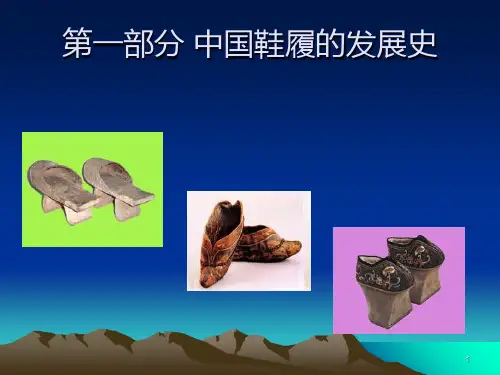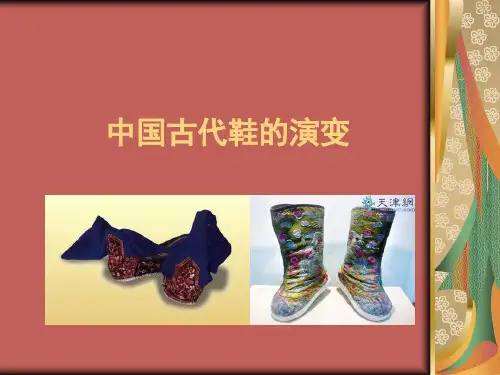鞋子的历史变迁演示文稿
- 格式:ppt
- 大小:6.98 MB
- 文档页数:18
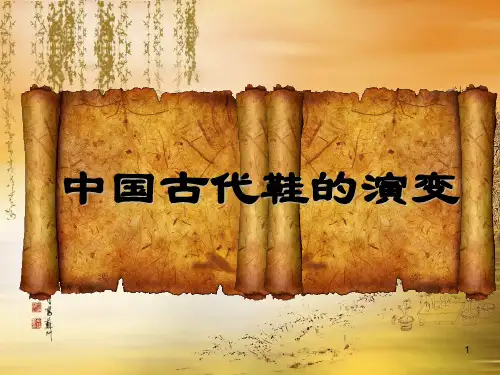




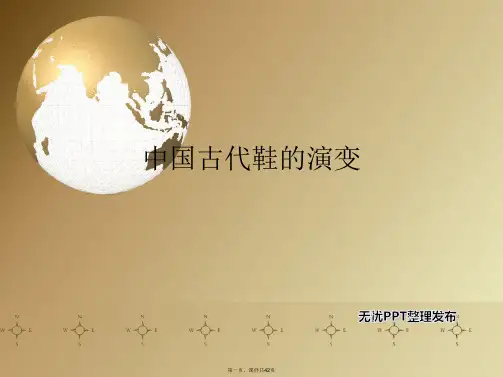
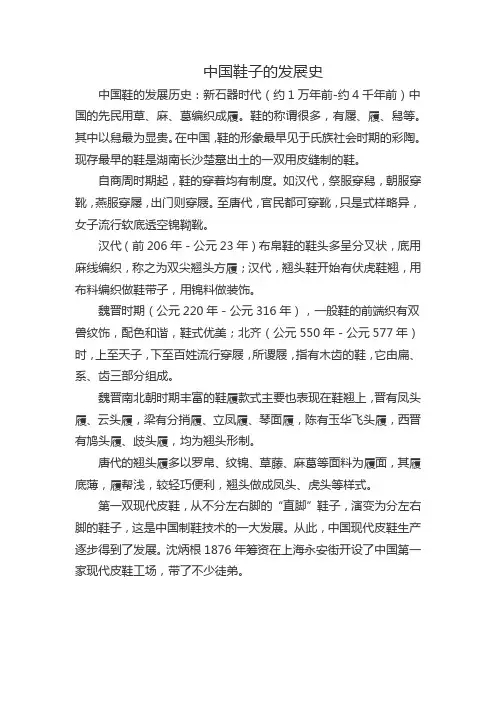
中国鞋子的发展史中国鞋的发展历史:新石器时代(约1万年前-约4千年前)中国的先民用草、麻、葛编织成履。
鞋的称谓很多,有屦、履、舄等。
其中以舄最为显贵。
在中国,鞋的形象最早见于氏族社会时期的彩陶。
现存最早的鞋是湖南长沙楚墓出土的一双用皮缝制的鞋。
自商周时期起,鞋的穿着均有制度。
如汉代,祭服穿舄,朝服穿靴,燕服穿屦,出门则穿屐。
至唐代,官民都可穿靴,只是式样略异,女子流行软底透空锦靿靴。
汉代(前206年-公元23年)布帛鞋的鞋头多呈分叉状,底用麻线编织,称之为双尖翘头方履;汉代,翘头鞋开始有伏虎鞋翘,用布料编织做鞋带子,用锦料做装饰。
魏晋时期(公元220年-公元316年),一般鞋的前端织有双兽纹饰,配色和谐,鞋式优美;北齐(公元550年-公元577年)时,上至天子,下至百姓流行穿屐,所谡屐,指有木齿的鞋,它由扁、系、齿三部分组成。
魏晋南北朝时期丰富的鞋履款式主要也表现在鞋翘上,晋有凤头履、云头履,梁有分捎履、立凤履、琴面履,陈有玉华飞头履,西晋有鸠头履、歧头履,均为翘头形制。
唐代的翘头履多以罗帛、纹锦、草藤、麻葛等面料为履面,其履底薄,履帮浅,较轻巧便利,翘头做成凤头、虎头等样式。
第一双现代皮鞋,从不分左右脚的“直脚”鞋子,演变为分左右脚的鞋子,这是中国制鞋技术的一大发展。
从此,中国现代皮鞋生产逐步得到了发展。
沈炳根1876年筹资在上海永安街开设了中国第一家现代皮鞋工场,带了不少徒弟。
由此制造皮鞋的技艺便传播开来,上海逐渐形成了皮鞋行业,上海许多老工人,不论识与不识,一提到沈炳根,大家都肃然起敬,称他是中国现代皮鞋的“祖师”。
中国鞋的分类:古鞋的种类以对材料来分,有草葛、布帛和皮革三种。
布帛鞋是指以大麻丝、绫、绸、锦等织物布鞋成的鞋。
中国古代的鞋主要有屦、舄、屐、靸等。
屦,有麻屦、葛屦、皮屦等。
麻屦最常用,以麻绳编成,编时边编边砸,使之结实。
葛屦穿于夏天,皮屦穿于冬天。
皮屦即早期皮鞋,另有革履、韦履之称。
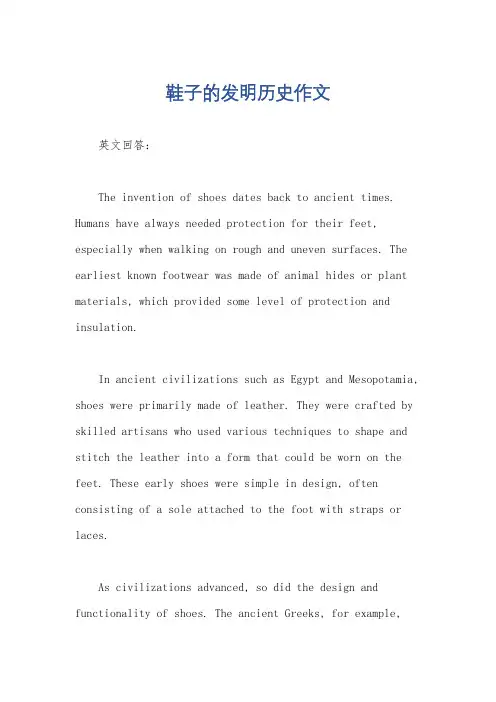
鞋子的发明历史作文英文回答:The invention of shoes dates back to ancient times. Humans have always needed protection for their feet, especially when walking on rough and uneven surfaces. The earliest known footwear was made of animal hides or plant materials, which provided some level of protection and insulation.In ancient civilizations such as Egypt and Mesopotamia, shoes were primarily made of leather. They were crafted by skilled artisans who used various techniques to shape and stitch the leather into a form that could be worn on the feet. These early shoes were simple in design, often consisting of a sole attached to the foot with straps or laces.As civilizations advanced, so did the design and functionality of shoes. The ancient Greeks, for example,introduced the concept of different shoe styles for different activities. They had sandals for everyday wear, boots for military purposes, and even shoes with elevated soles for actors in theater performances.The Romans further refined the art of shoemaking by introducing new materials and techniques. They developed the first known shoe factories and employed cobblers to mass-produce footwear for the growing population. The Roman footwear industry was highly advanced, with a wide variety of styles and designs available to suit different social classes and occasions.During the Middle Ages, shoemaking became a specialized craft. Guilds were formed to regulate the industry and ensure the quality of footwear. Shoes became more elaborate and decorative, reflecting the social status of the wearer. The wealthy would often wear shoes adorned with jewels and intricate embroidery, while the lower classes made do with simpler and more practical designs.The Industrial Revolution in the 18th century broughtsignificant changes to the production of shoes. The invention of machinery, such as the sewing machine, revolutionized the shoemaking process. Shoes could now be mass-produced at a faster rate and at a lower cost, making them more accessible to the general population.In the 20th century, advancements in materials and technology further transformed the shoe industry. Synthetic materials like rubber and plastic were introduced, providing new options for comfort and durability. Athletic shoes, especially sneakers, became increasingly popular, and brands like Nike and Adidas emerged as leaders in the market.Today, shoes come in countless styles, designs, and materials. They serve not only as a practical necessity but also as a fashion statement. The invention of shoes has undoubtedly had a profound impact on human civilization, providing comfort, protection, and style for our feet.中文回答:鞋子的发明可以追溯到古代。
